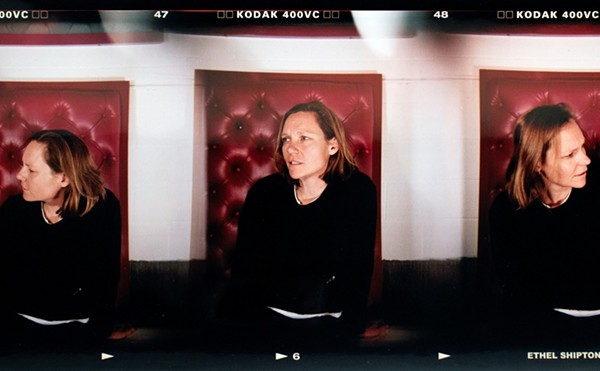When I get to Joe Lopez’s Gallista Gallery — a Southside art space Lopez downplays as rustic but strikes me as alive with color and culture — I encounter three artists drinking beer and listening to an oldies station. They’re building a platform for an upcoming art show/performance/wrestling extravaganza. Rudos y Tecnicos will feature roughly a dozen local painters and performers, many of whom are already training with Westside lucha libre wrestlers. The December 11 event will pit San Antonio-based artists against masked representations of war, domestic violence, homophobia, and DREAM Act-resisting Kay Bailey Hutchison.
“I just want whatever we show to be positive,” says Lopez, a celebrated painter of barrios and Chicano life. Judging from the cooperation and bonhomie of the guys with the hammers and saws, Rudos y Tecnicos is already absolutely charged.
“Lucha is really potent,” says Victor Payan, who along with his wife Sandra “Pocha” Peña Sarmiento orchestrates these ongoing art house wrestling matches through their project Aztec Gold. As a form of popular entertainment, lucha libre (or “free fighting”) often plays a political and social role in the Latin American scene. “In Mexico, you’ll have a luchador fighting the president. It’s an art form and an inspiration to a lot of people. The luchadores function as entertainers and sometimes court jesters, saying things that can’t be said any other way.”
In 2006, the couple — who had each worked in television and been active in the Latino film community for years — came to San Antonio during California’s collapsing economic bubble. Here they found a place where their vision could thrive. “Lots of local performers here already have the spirit of luchadores,” said Payan.
And the world needs them.
Whenever he travels back to California these days, Payan sees Border Patrol checkpoints becoming increasingly militarized. He feels that “we are in a new Civil Rights era. It’s just a matter of getting people together now.” Having artists perform the staged drama of lucha libre offers solidarity and a celebration of difference that just might lead to political awareness and action, he said.
The allure of lucha is undeniable, and in recent years it has been outright exploited by fast food commercials, car ads, and — depending on how you feel about that Nacho Libre movie — Jack Black.
There is an untapped power in the myth and kitsch of personas like Santos and Blue Demon and in all those Love and Rockets comics. When Peña Sarmiento sees these masked men and women coming to theatrical blows in the ring, she sees catharsis, a moment when the audience is freed to feel big pent-up emotions. “True art has to be cathartic, if it’s not cathartic then its decoration. Art needs to reach in and do something to you.”
Payan’s and Peña Sarmiento’s efforts strive to expose a deeper battle for action and commitment in the everyday. And the aim is also medicinal, explains Peña Sarmiento. “The yin-yang energy of the lucha … the laughter or the tears, they have the same effect of release on the body.” By examining the topics of poverty and oppression, violence, Arizona Senate Bill 1070, and the encroaching police state, through the comedic and celebrative arena of the lucha, “an audience will come to a greater, clearer way of looking at these issues.
“What really intrigues us is the concept of duality,” Peña Sarmiento continues, seeing the concept as a definite integer in Latin American consciousness. “It’s rooted in our Mesoamerican heritage, duality, the Tonal and the Nagual, you can look at them as good and bad, but we encourage people to go deeper and see the complexity.”
The French literary/cultural theorist Roland Barthes, when writing about French wrestling, observed that “the function of the wrestler is not to win; it is to go exactly through the motions that are expected of him.”
Payan appropriates this defining analysis for the lucha libre experience: “The rudo and the tecnico are the classic archetypes: there is the good guy who plays by the rules and the rudo who does not and is more dastardly. But it isn’t a good guy-bad guy thing, but a representation of duality. The rudos take the form of a kind of antagonist, a problem to be dealt with by the tecnicos.”
Does one need to be familiar with the tropes of lucha libre in order to enjoy this event?
Absolutely not, says Peña Sarmiento. “You find some kind of attachment to what you are seeing. I’ve brought people to the lucha that have no idea what it is or what to expect and they are friggin’ into it, screaming and cheering.” But beyond the brut fun, audience members may also find themselves taking a stand on border issues, health care, corporate greed, and social apathy.
“You can’t sit there and not root for something,” says Deborah Vasquez, whose powerful images of Aztec women in roles of anachronistic power will be on display at the event. The rudos y tecnicos, whatever they represent, “are asking people to take a stand.” •















